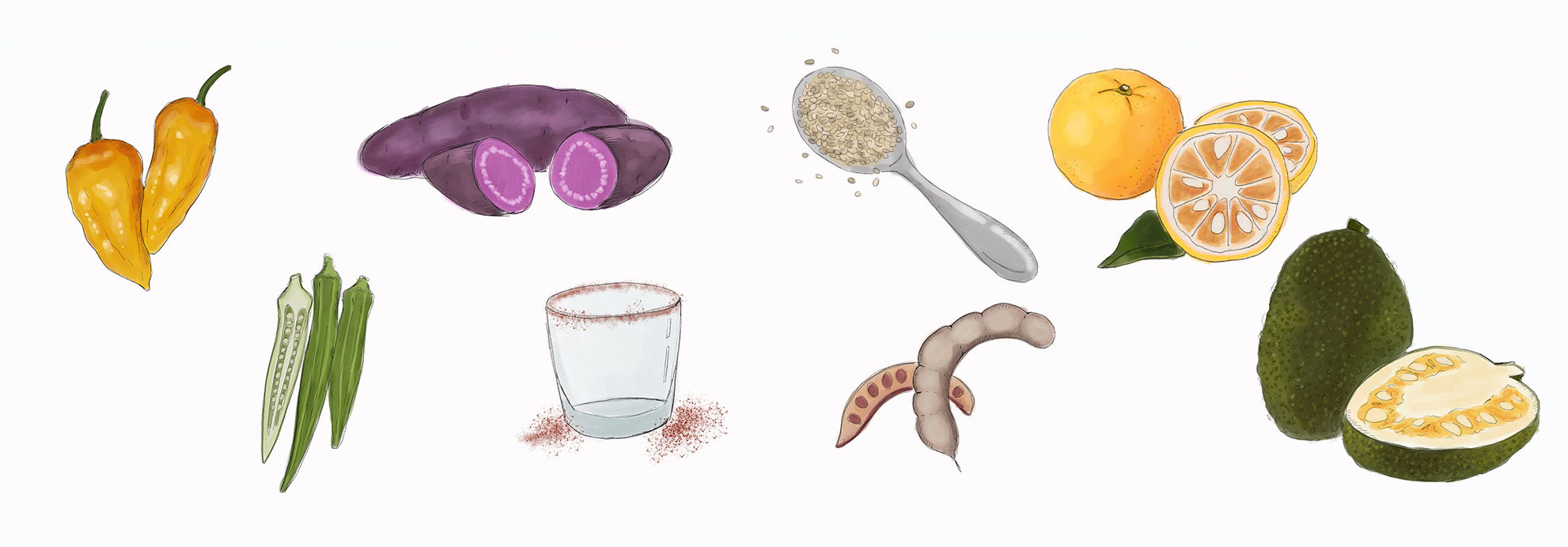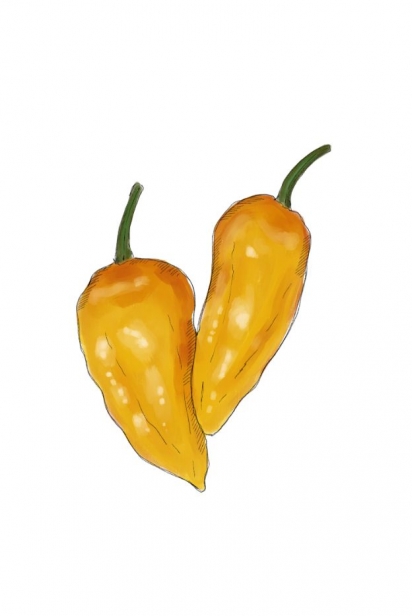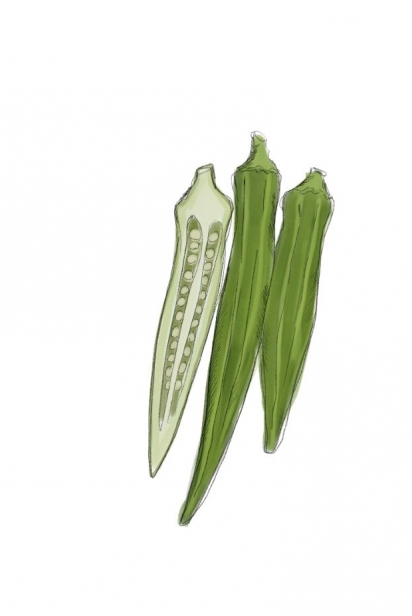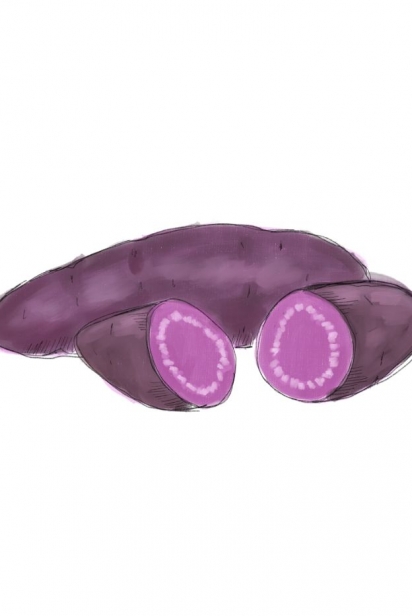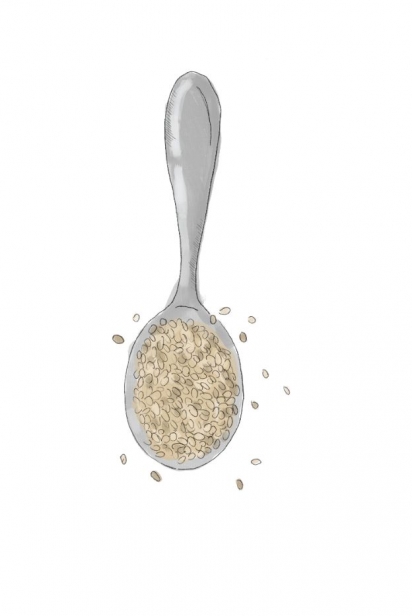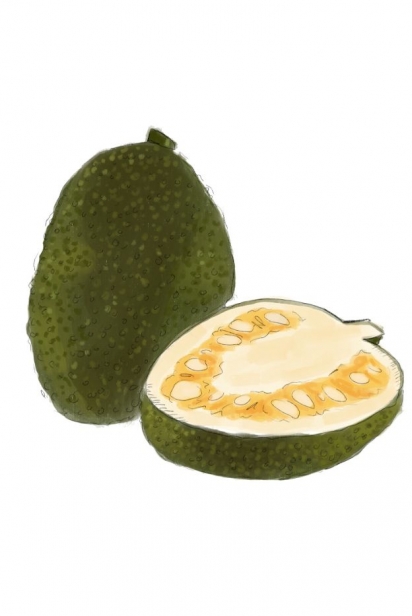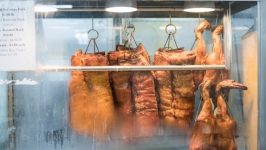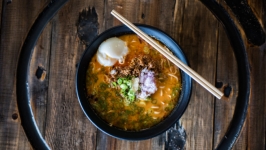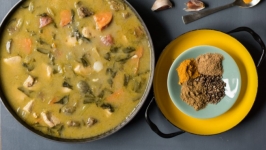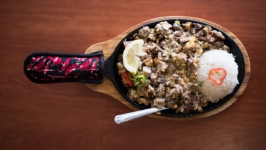Global Ingredients on Local Tables
We may not be traveling to exotic destinations these days, but many of the ingredients on our shelves have crossed vast distances and stretches of time to get to us, evolving along the way to embed themselves in our cultural narratives and family recipes. Here are the stories of eight ingredients with origins in distant places that have made their way into local markets, menus and kitchens.
DATIL PEPPERS
Description: A small, waxy variant of the Capsicum chinense pepper (the habanero-type pepper), which ripens to a distinctive yellow or orange color.
Place of origins: Originally Cuba, and brought to St. Augustine by jam maker Esteban B. Valls in the 1880s. Datil peppers soon became a favored staple of local Minorcan cuisine, giving rise to a local legend that they came from Minorca, though they are native to the New World.
Flavor: Sweet, fruity and exceptionally hot.
Uses: Sauces, marinades and dishes like Minorcan chowder.
Why it’s popular: Diners love the flavor and heat, plus the plants are easy to grow in NE Florida.
Where to find: Almost exclusively in the First Coast, especially St. Augustine. Your best bet for fresh peppers is local farmers markets. Many local stores and groceries carry datil pepper sauces.
OKRA
Description: Also known as lady fingers, okra is a flowering vegetable in the marrow plant family. The green pods are filled with crunchy white seeds suspended in a viscous slime.
Place of origins: Long cultivated across Africa and South Asia, okra came to the New World from West Africa via the transatlantic slave trade.
Flavor: Mild, grassy.
Uses: The pods can be stewed, fried, roasted, pickled, or eaten raw. It’s prized in West African, Southeast Asian, Creole, Indian and Mediterranean cuisine.
Why it’s popular: It’s abundant, nutritious and easy to cook. As your Southern grandma says, it’s good and good for ya.
Where to find: Any grocery, farmers' market or produce stand near you.
TAJÍN
Description: A dry rub seasoning made of three ingredients: salt, dried lime and three types of powdered chile peppers: guajillo, pasilla and chiles de árbol.
Place of origins: Mexico, created in 1985 by the Empresas Tajín company.
Flavor: A zingy melange of its three elements: salt, acid and heat.
Uses: Tajín can be sprinkled on pretty much anything. It’s good for seasoning meat, spicing up veggies and coating the rims of cocktail glasses. It’s especially popular with watermelon, tropical fruit and mango sorbet.
Why it’s popular: It’s a palatable, mass market combination of three common features of Mexican cooking: salt, citric sourness and chile heat.
Where to find: The spice or international foods section of most grocery stores, as well as Mexican restaurants and local ice cream shops — ask for a Mangonada.
UBE
Description: A sweet yam with a bold purple color and starchy, creamy texture.
Place of origins: The Philippines and other Southeast Asian islands.
Flavor: Sweet, nutty and earthy, akin to taro or sweet potatoes.
Uses: Ube is a mainstay in Filipino desserts, including pastries, ice cream and ube halaya (ube jam).
Why it’s popular: Its sweetness and vibrant purple color make it perfect for desserts that look as good as they taste.
Where to find: Look for ube desserts at local Filipino eateries like A&D Manila, Nino’s Pinoy Express, or PhilAm Eatery. Find fresh ube at La Salsa Market.
BENNE
Description: Derived from the flowering Sesamum indicum plant, benne is a robust heirloom variety of sesame, the seeds of which are grown and cultivated from pods.
Place of origins: Originally cultivated in Subsaharan Africa and brought to the Carolina, Georgia and Florida Low Country via the slave trade.
Flavor: Nutty, rich and buttery.
Uses: A staple of Gullah-Geechee cuisine, benne seeds traditionally supplement rice, stews and seafood, and yield a flavorful oil. It’s well known today via benne wafers, and is making a comeback among Southern chefs.
Why it’s popular: They’re sesame’s cultured cousin, and a vintage Southern staple on the rise.
Where to find: Tough to find in Northeast Florida. Saturiwa Trading Company carries them and Oliver Farm in central Georgia sells benne oil and flour.
TAMARIND
Description: The versatile fruit of a tropical hardwood in the legume family. The brown fruit pods are filled with seeds and fibrous pulp that becomes sweet, gummy and figlike in texture as it ripens.
Place of origins: Originally cultivated in Subsaharan Africa and South Asia, tamarind came to the Americas through European colonization.
Flavor: Varies widely from sweet to tart to very sour, depending on the fruit’s ripeness and the use.
Uses: A variety of chutneys, curries, sauces and marinades feature tamarind. It’s a key flavor in phad thai and various Asian and Latin dishes. In the West, it’s an ingredient in Worcestershire sauce.
Why it’s popular: The full, sour flavor complements a wide variety of sweet and savory dishes.
Where to find: Indian and Asian groceries like Patel Brothers and Raja Indian Spices carry tamarind paste and chutney, as does Grassroots Natural Market and some major grocery chains.
JACKFRUIT
Description: The world’s largest fruit, reaching up to 35 inches long and 120 pounds in weight. A “multiple fruit” similar to a pineapple, it consists of thousands of tightly packed flowers grown together in a mass within a hard, scaly shell. It grows on the aptly named jacktree.
Place of origins: Originally India and Southeast Asia, now cultivated in various tropical regions, including South Florida.
Flavor: Mild when young, and like Juicy Fruit gum when ripe. Young jackfruit has a distinctive dense, shreddable texture similar to pulled pork.
Uses: In India, jackfruit is used in curries and chakkavaratti (jackfruit jam), and eaten raw. In the West, it has boomed as a meat replacement in plant-based dishes.
Why it’s popular: That texture and its versatility.
Where to find: Asian groceries like Patel Brothers, Jax Oriental Market, Tha Mao Oriental Market and Cambodian Oriental Store carry it fresh; many major groceries carry it canned or processed. Find it in shredded form on the menus of local vegan restaurants.
YUZU
Description: A small fragrant citrus thought to have developed as a hybrid of the mandarin orange and Ichang papeda. The fruits are between 2 and 3 inches in diameter, green when young and yellow when ripe.
Place of origins: Originally China, but mostly cultivated in Japan and South Korea.
Flavor: Tart and citrusy, like a grapefruit crossed with a mild lemon.
Uses: Various Japanese and Korean dishes. Yuzu juice and rinds, and sauces made from them like ponzu, are used to flavor meat, fish and mushrooms, as well as candies and drinks.
Why it’s popular: Like lemons and other citruses, yuzu brings a flavorful punch to savory and sweet dishes alike.
Where to find: Fresh yuzu is rare, but sauces can be found in Asian groceries and other markets’ international aisles, as well as on the menus of cocktail bars.


